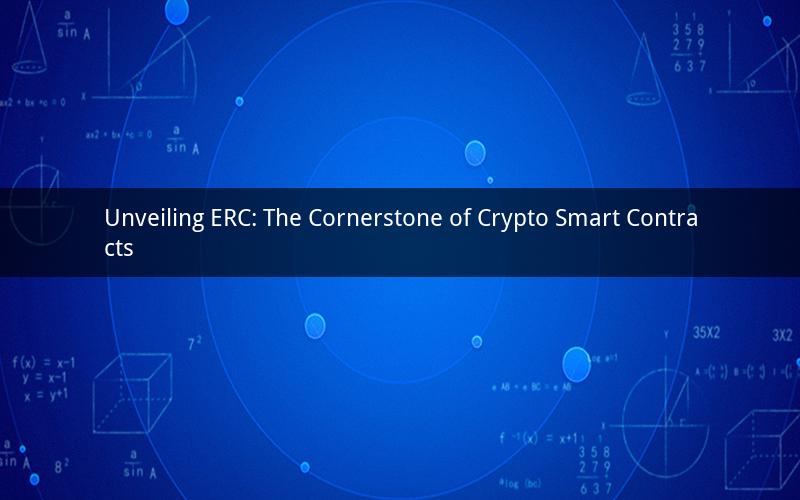
In the rapidly evolving world of cryptocurrency, the term "ERC" has become an integral part of the ecosystem. ERC stands for Ethereum Request for Comments, and it is a set of technical standards used for implementing smart contracts on the Ethereum blockchain. This article delves into the essence of ERC, its significance in the crypto space, and how it has transformed the way we perceive digital assets.
Understanding ERC
ERC is a series of standards that define the rules and guidelines for smart contracts on the Ethereum network. It was introduced in 2015 by a group of Ethereum developers with the aim of creating a common framework for building and deploying decentralized applications (DApps) on the platform.
ERCs are essentially protocols that define how smart contracts should interact with each other and with the Ethereum blockchain. They are not part of the blockchain itself but rather a set of rules that smart contracts must adhere to. This ensures that all smart contracts on the Ethereum network can communicate and work together seamlessly.
Significance of ERC
1. Standardization: One of the primary benefits of ERC is standardization. By providing a set of rules and guidelines, ERC ensures that smart contracts are interoperable and can interact with each other without any issues. This standardization has led to the development of a vast ecosystem of DApps, making Ethereum the most popular platform for building decentralized applications.
2. Security: ERCs also contribute to the security of smart contracts. Since they define the rules and guidelines for smart contracts, they help in identifying potential vulnerabilities and preventing malicious attacks. This has made Ethereum a more secure platform for deploying DApps.
3. Simplification: ERC has simplified the process of building and deploying smart contracts. By providing a common framework, ERC has reduced the complexity associated with developing smart contracts from scratch. This has encouraged more developers to enter the Ethereum ecosystem and contribute to its growth.
4. Innovation: ERC has fostered innovation in the crypto space. As developers adopt ERCs, they can build new and exciting DApps that were previously unimaginable. This has led to the emergence of various industries, such as decentralized finance (DeFi), non-fungible tokens (NFTs), and more.
Popular ERC Standards
1. ERC-20: Perhaps the most popular ERC standard, ERC-20 defines the rules for fungible tokens on the Ethereum network. It has become the industry standard for creating and exchanging tokens, with many projects adopting this protocol.
2. ERC-721: ERC-721 is the standard for creating non-fungible tokens (NFTs). It has gained significant attention in recent years, with the rise of projects like CryptoKitties and NBA Top Shot.
3. ERC-1155: ERC-1155 is a unique standard that allows for the creation of both fungible and non-fungible tokens on a single contract. This has made it more efficient for developers to build and manage various token types within a single smart contract.
4. ERC-20 vs ERC-721: Although both ERC-20 and ERC-721 are standards for creating tokens, they serve different purposes. ERC-20 is used for fungible tokens, which are interchangeable and have the same value. ERC-721, on the other hand, is used for non-fungible tokens, which are unique and cannot be exchanged on a one-to-one basis.
5. ERC-777: ERC-777 is a standard that builds upon ERC-20 and ERC-721, adding features like token transfers and approvals. It aims to provide a more flexible and secure way of handling token transfers on the Ethereum network.
Challenges and Future of ERC
Despite its numerous benefits, ERC faces some challenges. One of the main challenges is scalability, as the Ethereum network can become congested during peak times. This has led to the development of alternative platforms like Binance Smart Chain and Polkadot, which aim to offer scalable solutions for smart contracts.
The future of ERC seems promising, as developers continue to explore new ways to enhance the Ethereum ecosystem. With the introduction of Ethereum 2.0, which aims to improve scalability and security, ERC is expected to play a crucial role in the future of decentralized applications.
Frequently Asked Questions
1. What is the difference between ERC-20 and ERC-721?
ERC-20 is a standard for fungible tokens, which are interchangeable and have the same value. ERC-721, on the other hand, is a standard for non-fungible tokens, which are unique and cannot be exchanged on a one-to-one basis.
2. Can a single smart contract implement multiple ERC standards?
Yes, a single smart contract can implement multiple ERC standards. This allows developers to create more complex and versatile DApps.
3. How do ERCs contribute to the security of smart contracts?
ERCs define the rules and guidelines for smart contracts, which help in identifying potential vulnerabilities and preventing malicious attacks. This makes the Ethereum network more secure for deploying DApps.
4. What is the role of ERC in the DeFi space?
ERCs have played a significant role in the DeFi space by providing a standardized framework for building and deploying decentralized financial applications. This has led to the growth of various DeFi projects on the Ethereum network.
5. How can ERC standards be improved?
ERC standards can be improved by addressing existing issues, such as scalability and security, and by introducing new features that can enhance the functionality of smart contracts. Collaboration between developers, researchers, and Ethereum community members is essential for the continuous improvement of ERC standards.